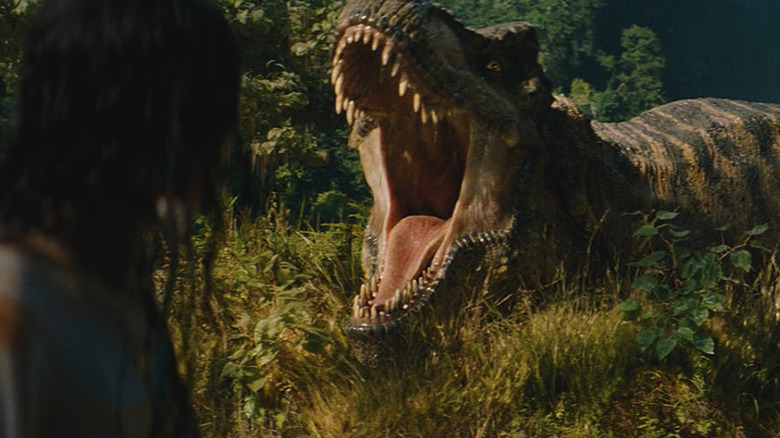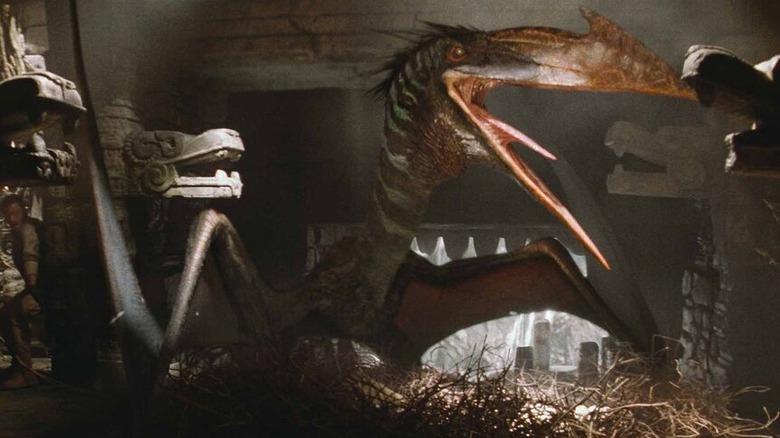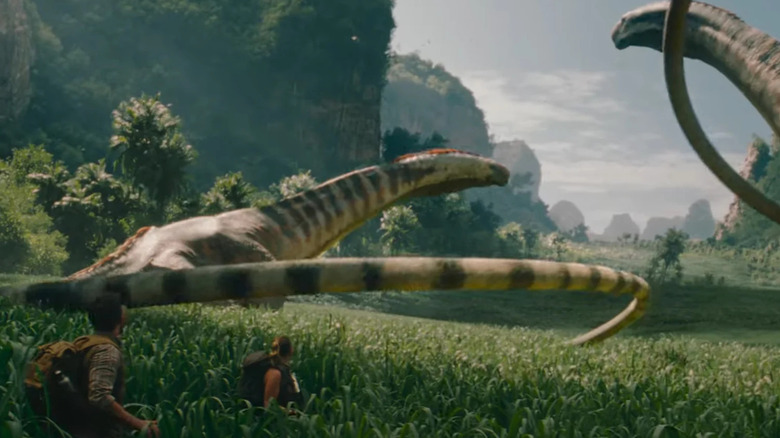Jurassic World Rebirth Finds A Surprising New Meaning For The Franchise's Dinosaurs
In Steven Spielberg's groundbreaking 1993 blockbuster "Jurassic Park," the billionaire behind the titular hoped-for attraction, John Hammond (Richard Attenborough), is practically buzzing with giddy anticipation at how successful his venture will likely become. He crows that his team who helped bring dozens of extinct species of dinosaurs back to life "spared no expense," and that everything in the park boasts "absolutely spectacular designs." Although the small group of experts Hammond has invited to tour the park are indeed impressed with what he's done, having strong emotional responses to the sights of actual living dinosaurs walking the Earth, they begin to have serious doubts as reality begins to set in. Dr. Ian Malcolm (Jeff Goldblum) sums up the potential folly of Jurassic Park succinctly: "Your scientists were so preoccupied with whether or not they could, they didn't stop to think if they should."
"Jurassic Park," both the first movie and Michael Crichton's source novel, uses the idea of a potential dinosaur theme park as a metaphor for all manner of foibles surrounding the progress of science and technology, particularly humanity's penchant for leaping before it looks. It's part Mary Shelley, part "Westworld," part "King Kong," and the film not only became a smash hit, but helped solidify the use of Computer Generated Imagery in cinema. Just a few years later, CGI had become a staple in nearly every genre movie, with huge advancements and refinements to the tech happening with each passing year.
Yet as Claire Dearing (Bryce Dallas Howard) explains in "Jurassic World," the public's appetite for more and better things is insatiable once whetted. While the "Jurassic" franchise took a number of conceptual turns and added several new characters to the mix (not to mention featuring a new dino or two with each sequel), there's no doubt that the tremendous interest and love garnered by the first film has waned. The latest entry, "Jurassic World Rebirth," seems to acknowledge this, metaphorically comparing the slow extinction of the reborn dinosaurs to the creeping demise of the film industry. Ironically, in both cases, we have "Jurassic Park" to partially blame.
Jurassic Park Rebirth acknowledges that the magic of visual effects is all but gone
The world-building in "Rebirth" follows on from the prior "Jurassic World" trilogy that writer/director Colin Trevorrow and his collaborators made. In those films, the genetically engineered dinosaurs originally developed for Hammond's abandoned park on Isla Sorna and the subsequent Jurassic World resort were eventually unleashed onto the entire planet. For a time, these creatures appeared to be cohabitating with humans and other animals. The trilogy seemed to be carrying on a central metaphor for the dinos that Spielberg had begun with "The Lost World: Jurassic Park," which is that they're a stand-in for animals and the natural world in general. The films advocated for general conservation and preservation of the dinosaurs, with Malcolm's chaos theory made manifest in the way that the entire world was now forced to reckon with these new species.
"Rebirth" adds a new wrinkle to all this, as writer David Koepp begins the film with a title crawl which explains that the majority of dinosaurs have begun to die out since the events of "Dominion." The creatures are now succumbing to too many differences in Earth's modern climate than the prehistoric climate they were originally used to (a plot point which echoes H.G. Wells' "The War of the Worlds," one adaptation of which was made by Koepp and Spielberg in 2005). Although the dinosaurs are still able to live in areas close to the Earth's equator (which mimics their traditional climate close enough to allow them to thrive), the decline of the dinos is made even more tragic and acute by the fact that public interest in them has waned now that the entire world has become used to their presence. The film's opening sequence shows how a Brachiosaurus, once the source of awe for Alan Grant (Sam Neill) and Ellie Sattler (Laura Dern), has become a mere incidental road hazard causing a traffic jam.
It's a deft visual metaphor on behalf of Koepp and director Gareth Edwards, an image as good as any to indicate how what once was thrilling and novel has become commonplace for jaded audiences. Combined with the lamentations of Dr. Henry Loomis (Jonathan Bailey) that attendance at his history museum has severely dropped off, Koepp and Edwards aren't being subtle about how these dinosaurs are a stand-in for visual effects in genre movies, if not for cinema in general. Recently, there's been lots of discussion about how films have become less of a draw for general audiences, and while there are numerous social and economic reasons for this, Edwards and Koepp correctly pinpoint the saturation and ubiquitousness of visual effects films as one key factor. How can any audience be filled with awe and wonder again when they've been trained on decades of films where the effects are, potentially in the minds of an average viewer, made with the apparent push of a few buttons?
How Jurassic Park Rebirth proposes to bring some wonder back to the movies
Of course, no visual effects films are made so simply as that conventional wisdom would have it. Part of the problem is our lack of common language when discussing visual effects, thus resulting non-critiques such as "the CGI looks good/bad" becoming the height of discussion about them. Another problem facing visual effects is that, despite the large amount of effort and creativity that goes into their creation, too many directors and producers have a lackadaisical "let's do it in post" mentality. It's a crutch that has resulted in some classic techniques of trick photography and other slight of hand illusions being either overlooked or forgotten, as my discussion with David F. Sandberg about using such devices on "Until Dawn" demonstrates. All of this has contributed to a growing apathy toward the visions cinema can provide, one that a study of film history only exacerbates. As Edwards himself said to Deadline on the red carpet of "Rebirth," most movies that he considers masterpieces were made prior to the original "Jurassic Park," indicating that technological progress isn't necessarily always an improvement.
As such, Edwards and Koepp use "Jurassic World Rebirth" to try and make a case for how visual effects films can still hold the power to delight, entertain, and thrill the only way they know how: by using pure cinematic craft. "Rebirth" is not a gimmick film; it doesn't feature some sort of new process or tech that it's showing off, nor is it trying to trade on a nostalgia factor by solely using animatronic or practical effects. (In fact, it appears that "Rebirth" has no practical dinosaurs, a notable difference from just about every previous "Jurassic" film.) Instead, the movie relies on providing a genuine sense of scale, stakes, and suspense, where it's not the visual effects per se that astound, but the circumstances surrounding them and their presentation. During the movie's almost prerequisite "someone sees a benign dinosaur and is awed" scene, "Rebirth" did something I thought impossible: It made me emotional, instilling in me that feeling of wonder I thought was gone from these movies. It's all due to the way Edwards shoots the scene, the way the VFX artists deliver the animation of the dinosaurs, and the way Bailey plays the moment. It is, in short, the magic of movie-making in action.
That's clearly not enough for everyone, as the more hostile reactions to "Rebirth" indicate. For these folks, it seems familiarity has indeed bred contempt, as they reject yet another "Jurassic" sequel. While purely good filmmaking is enough for me and seems to be the only way forward for the "Jurassic" movies should they continue, there's no question that future filmmakers should heed the warnings of "Rebirth" when it comes to visual effects. If we're not careful, the excitement of the movies could indeed die out, and this is a medium that no one should hope goes extinct.


